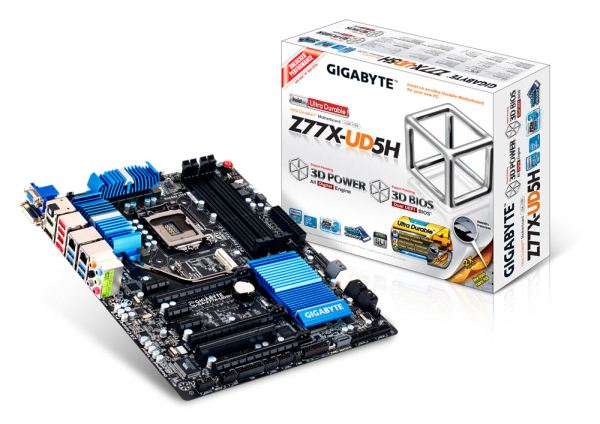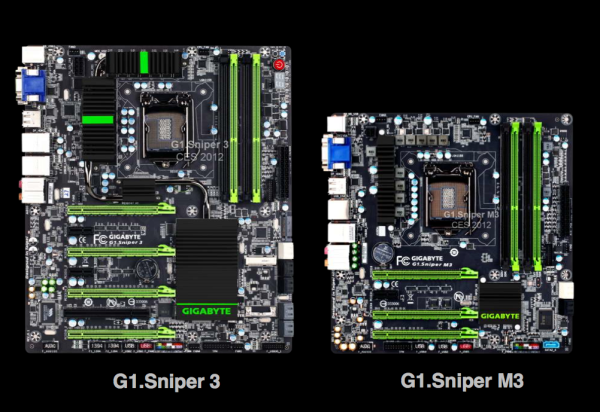A Brief Look at Some Upcoming 7-Series Motherboards
by Ian Cutress on March 9, 2012 5:00 PM EST- Posted in
- Motherboards
- Intel
- H77
- Z77
Gigabyte
Whenever a new chipset comes out, Gigabyte tend to do one of two things – either release a few boards to cover particular price points (usually models from UD3 to UD7), or release more than 10 or even 20+ products for the chipset. This latter method of attacking the market could perhaps overwhelm users into deciding which model to purchase, or that reviews could end up with so many boards to review it is hard to decipher which are the important ones. Nevertheless, Gigabyte for the 7-series launch has decided to attack the market with the latter, in the following models:
Gigabyte G1.Sniper 3
Gigabyte G1.Sniper M3
Gigabyte GA-Z77X-UD5H Wifi
Gigabyte GA-Z77X-UD5H
Gigabyte GA-Z77X-UD3H Wifi
Gigabyte GA-Z77X-UD3H
Gigabyte GA-Z77X-D3H
Gigabyte GA-Z77-D3H
Gigabyte GA-Z77-DS3H
Gigabyte GA-Z77MX-D3H
Gigabyte GA-Z77M-D3H
Gigabyte GA-H77-DS3H
Gigabyte GA-H77M-D3H
Gigabyte GA-B75M-D3H
Gigabyte GA-B75M-D3V
‘D’ means ‘All solid capacitor design’
‘U’ means ‘Double copper PCB design’
My guess is that this list is by no means complete, exhaustive or final (and perhaps includes models for sale in other parts of the world). No doubt we will see a UD4/UD4H, all the way up to UD7 as well. Gigabyte does have a microsite dedicated to their 7-series products, which does provide an informative list of what should be on offer.
The main features Gigabyte is going to be advertising with their 7-series launch is the almost ubiquitous placing of mSATA connectors on most of their boards, and that the UD3 and above boards come with wifi cards.
Gigabyte GA-Z77X-UD5H
Almost at the top of Gigabyte’s range at release is the GA-Z77X-UD5H. We see that the placement of the mSATA port is just below the CPU, which in the grand scheme of things should be ok as long as the user never wants to remove it (I can just imagine it being relatively stressful to take it out when a system is built and in a case). Also, all the boards in the range have both D-Sub and DVI outputs on the IO, which means on some models that they take up space for any PS/2 ports. This is despite the UD5H still sporting a PCI slot for legacy, even if it is taken up if a second dual slot GPU is used. As always, all Gigabyte models should support TPM, and in the case of the UD5, we have extra SATA ports and dual USB 3.0 headers onboard – all of which would be obscured by a full length third GPU.
G1.Sniper 3 and G1.Sniper M3
If we go back all the way to CES this year, Anand caught glimpse of the G1.Sniper series that Gigabyte had on display:
Given what we know about the Gigabyte range, we have some features to point out – if you want mSATA, it looks like you have to invest in a full size ATX style board. Unfortunately, that also means investing in a board that uses a PLX chip to give 4-way x8 performance for multi-GPU setups. Both boards seem to have specialized capacitors to deal with their audio solutions, which on the Gigabyte microsite states is the Creative Sound Core 3D – which is a step in a positive direction from normal Realtek audio solutions.


















55 Comments
View All Comments
ComputerGuy2006 - Friday, March 9, 2012 - link
I like how both the ASUS P8Z77 WS and the ASUS P8Z77-V Deluxe have dual NIC. But without a hex core to go with these mobo's look like I am going to be stuck with my slow 1336 till ivy bridge-e....johnpombrio - Saturday, March 10, 2012 - link
Take a look at Anand's review of Ivy Bridge. He uses the SB- E as part of the benchmarking. It turns out that having those 6/12 cores and the extra cache did not make these expensive chips run most stuff any faster than the much less expensive IB. That decided me right there to upgrade to IB rather than to the SB -E chips. So Ivy Bridge with a Z77 chipset is the way to go unless you are doing some serious stuff with transcoding or double or triple SLI..euler007 - Sunday, March 11, 2012 - link
But people on the internets will have more cores than him!lunarx3dfx - Monday, March 12, 2012 - link
My 1366 920 is still hanging in there pretty good, and I was waiting on SB-E to upgrade, but I'm with John. The performance upgrade wasn't significant enough to justify the cost, so it looks like it'll be IB for me. Who cares about 6 or more cores if there isn't a huge performance gain?aguilpa1 - Monday, March 12, 2012 - link
I'm in the same boat, Don't let Intel know but there is usually one GRAND chip that can hold its own against several generations of mediocre chips before an upgrade is needed. The i7 920 when OC'ed is one and the Q6600 was the one before that. I had both and now I'm on the 920 and there doesn't seem to be a good reason to upgrade until IB.Samus - Tuesday, March 13, 2012 - link
I've had an Asus x58 chipset board with a i7-950 for over 3 years, I have upgraded nothing. It is still faster than 90% of the computers on the market, and within 20% of the performance of mainstream Sandy/Ivy Bridge chips.There is no compelling reason to upgrade to Socket 1155 from Socket 1366. I agree with john and lunar in waiting for the next socket/architecture.
Intel really outdid themselves with Bloomfield.
adece - Friday, March 9, 2012 - link
Unless Gygabyte or ASRock puts WiFi on a sub $220 Mobo of their's, my money is going to Asus.deltatux - Friday, March 9, 2012 - link
It would have been nice if ASUS or GIGABYTE would put at least one or two PCI slots. There are still a lot of sound cards and TV tuners that are mainly PCI.It would definitely suck if I am forced to upgrade my sound card which works perfectly just because new motherboards force users to upgrade even though the majority is still on the older tech.
Don't get me wrong, PCI is long overdue to get replaced but honestly, there's still too many of these expansion cards which are still reliant on the older PCI bus.
Concillian - Friday, March 9, 2012 - link
Several Z68 / P67 mobos have PCI slots, will support IB, and should be available for a while.The Z77 chipset has no PCI outputs. It's a little unfair to blame the motherboard makers for not including a feature that is not in the base chipset. It can't be simple to just slap a PCI slot on a mobo with a chipset that is designed not to use them.
DanNeely - Friday, March 9, 2012 - link
Theoretically they could use a PCIe-PCI bridge chip to add a legacy slot; but the cost of doing so (to include the engineering work to integrate it) would probably exceed that of buying a higher end chip from Intel.